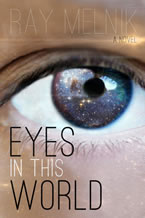Article first published as Book Review: Eyes in this World by Ray Melnik at Blogcritics.
September 25, 2013
Eyes in this World
Ray Melnik
iUniverse (2013)
ISBN: 978149170776
Final Book of Tetralogy is Heartfelt Science Fiction
 Although I’m not a big reader of science fiction, I appreciate a heartfelt story about real people with real problems, so when I read Ray Melnik’s first novel, The Room, I was instantly hooked. In that book, I also learned about string theory and other fascinating aspects of science that were new to me at the time—it certainly helped me to understand what the characters on The Big Bang Theory were talking about. Without hesitation, I then followed Melnik’s characters through The Room’s sequels: To Your Own Self Be True, Burnished Bridge, and now, the newly published and final volume of this sci-fi tetralogy, Eyes in this World.
Although I’m not a big reader of science fiction, I appreciate a heartfelt story about real people with real problems, so when I read Ray Melnik’s first novel, The Room, I was instantly hooked. In that book, I also learned about string theory and other fascinating aspects of science that were new to me at the time—it certainly helped me to understand what the characters on The Big Bang Theory were talking about. Without hesitation, I then followed Melnik’s characters through The Room’s sequels: To Your Own Self Be True, Burnished Bridge, and now, the newly published and final volume of this sci-fi tetralogy, Eyes in this World.
It’s been three to four years since I read the other novels, so when I started Eyes in this World, it took me a little while to remember all the characters, but after a few pages, I was hooked again. And who wouldn’t be when you have characters and situations like Kyle, a scientist who has opened a rift into a parallel universe where he can speak to another Kyle, who is really himself, but whose life is slightly different? These two Kyles have communicated over the course of many years. Parallel Kyle, unlike earthly Kyle, married the woman he loved, and he inspired earthly Kyle to go after the same woman and marry her as well. Also in this parallel universe, world events are slightly different—Al Gore rather than George W. Bush became president, and while 9/11 occurred, it only led to the invasion of Afghanistan and not Iraq. Also fascinating is that despite differences, ultimately, the parallel worlds tend to converge back together so that events and people are fairly similar. This fact will play an important role in the events that lead to the book’s stunning conclusion.
In addition to Kyle, there are other characters like Rael, who has lost his memory, a situation that a parallel universe might be able to remedy, and Alex, who left earth twelve years ago to travel through a wormhole to what he believed was another planet, only to find himself on earth, but twelve years in the future. And then there’s Adam, which is more human than computer program—not the first time this idea has appeared in fiction, but Adam is certainly one of the more likeable and believable of his kind. Kaela is also back from the earlier books, and Eyes in this World is told alternately from her and Kyle’s perspectives.
The science fiction aspects of this book are fascinating to me because they supersede stories of people flying around in spaceships in other galaxies. Instead, they are real people with real problems who might be my own friends or family members. For this reason, I think Ray Melnik really pushes against the boundaries of the science fiction genre to create realistic, dramatic, and emotional stories. One reason why I don’t read a lot of science fiction is because it sort of creeps me out to think there might be aliens out there who might harm us, and while I enjoy speculating about the possibilities in the vast universe, it can also be overwhelming to think about it too much.
Melnik gets that science and the universe can be overwhelming. He tries to make sense of much of it, but he also writes from the premise that it is ultimately more than a human can understand. In fact, in the book’s introduction, Melnik quotes Carl Sagan to sum up what is really this book’s theme, “For small creatures such as we the vastness is bearable only through love.” Love pervades all of Melnik’s stories. It is only in human relationships that we can really hope to find meaning, and as a result, at the heart of each of these novels, Melnik has revealed truths about love and human relationships that will bring realizations about life to readers and may even move them to tears. In the end, Melnik shows how the power of the heart is what can make a difference to our lives amid all that we cannot understand.
If you love science fiction, you’re in for a treat with Eyes in This World, and if you have avoided science fiction in the past because it felt too unrealistic, you’ve now found the right author to read. Begin with the first book and read all four of them, and instead of being overwhelmed, you will have a new appreciation for science and the universe it explores.
— Tyler R. Tichelaar, Ph.D. and award-winning author of The Best Place

